By OWEN C. THOMASSON III and MICHAEL J. BARAKEY
In “Mayday Drill: Years in the Making” (Fire Engineering, April 2023), the Suffolk (VA) Department of Fire & Rescue (SFR) provided an overview and lessons learned from the department’s first of two departmentwide, full-scale Mayday exercises and drills that occurred in February and March 2022. Incorporating lessons learned from that first full-scale exercise, the department completed the second phase of full-scale Mayday drills in February and March 2023.
With the two exercises completed, the department has a better understanding of where we are, where we want to be, and what we need to accomplish to get there. In addition, SFR has experienced four Mayday events over the past five years, one of which was featured in Fire Engineering (Fire Focus: “Anatomy of a Virginia Apartment Fire with Rescues and a Mayday,” May 2023). In that incident, SFR applied what it had learned in the first Mayday exercise.
Background
To accomplish the second phase of the department training, the department used the same decommissioned elementary school. Starting in February 2023, the department delivered 12 four-hour evolutions over two months. More than 300 firefighters, officers, and dispatchers participated in the second exercise, a more challenging scenario than the evolution completed the year prior. As with the 2022 iteration, each scenario included three engines, one ladder, one heavy rescue, one advanced life support (ALS) ambulance, one emergency medical services (EMS) supervisor, one safety officer, and two battalion chiefs.
The first evolution, in February 2022, challenged crews with zero visibility and obstacle-strewn hallways as they progressed to find a firefighter pinned by a wall collapse and heavy debris in a science lab. The incident concluded once the firefighter was rescued and the fire was extinguished.
Based on the lessons learned from all 12 exercises in 2022, the next phase was designed to refine the skills used in executing a successful Mayday. The common themes identified in the 2022 evolutions to be readdressed before the 2023 evolutions concerned radio communications, prefire planning, firefighter removal techniques, using rescue equipment in fire conditions, using rapid intervention team (RIT) packs in confined spaces with zero visibility, self-contained breathing apparatus (SCBA) familiarity in critical scenarios, using tactical/Mayday worksheets, calling for a second alarm early in a Mayday event, using the incident command system (ICS) terminology, using multiple tactical channels simultaneously, and the dispatcher’s role in fireground communications on tactical channels.
In the interval between the Mayday exercises, the training division concentrated on in-station training, tabletop drills, returning to the decommissioned elementary school for battalion-led training, and station-led training at the burn building to reinforce the lessons learned from the 2022 exercise and to prepare for the second delivery. Because of the focus on Mayday response over the past two years, facilitators were eager to see how much the department had grown since the last exercise and anticipated that the results in the February 2023 delivery would be favorable.
2023 Mayday Full-Scale Exercise
In the 2023 full-scale exercise, the scenario was upgraded and enhanced to build on the previous exercise. The facilitators developed a completely different scenario using the opposite end of the elementary school, to which crews had not been exposed in 2022. It began with a commercial fire alarm at the elementary school, with an initial response of one engine and one ladder.
The alarm was simulated to occur at 0600 hours. Crews received a prefire plan that included the building’s layout, the exits, the fire alarm panel, and so on. Smoke machines produced heavy smoke conditions so first-arriving crews would observe heavy smoke conditions in the cafeteria/kitchen area on arrival.
Evaluators and facilitators were pre-positioned for all scenarios to ensure that the scenarios were consistent for each evolution and that evaluation criteria were consistent for all scenarios. Facilitators were assigned specific areas in which to evaluate performance, including the exterior, the command post, and in the interior. Evaluators were assigned to the interior fire area, with three in the Mayday area (a cafeteria also served as an auditorium, with a stage built at one end for school programs) and one in the kitchen.
On Arrival
The first-arriving company performed a scene size-up, exited the truck, and gained entry to the A side (the front door) to access the fire alarm panel (photo 1).
The first-arriving officer established command during the scene size-up, and crews entered the A side entrance (the front door) to access the fire alarm panel. After seeing the alarm panel indicating the activated kitchen detector, crews continued to that corridor. After encountering a light haze in the hallway, command (the first-arriving engine company officer) requested a full commercial structural response through the on-site dispatcher participating in the exercise. On opening the cafeteria door to gain entry to the kitchen and encountering heavy smoke (photo 2), the crew pulled an attack line, and crews began searching for the fire.
Soon after the full structural response began arriving, most of the exercises had the additional arriving units perform similarly. The second-arriving company performed water supply and search. The first-arriving battalion chief assumed command. The third-arriving company was assigned as the RIT. The fourth-arriving company was assigned a second attack line and search. The ALS ambulance was staged and prepared to initiate treatment and transport. The fifth-arriving company staged and awaited orders from command. The second-arriving battalion chief reported to the command post and prepared to work the Mayday and additional tactical channels. The EMS supervisor reported to the command post as a liaison to the incident commander (IC). The safety officer was assigned to fireground safety as part of the command staff.
As crews entered the cafeteria, they encountered zero visibility; the facilitators told them that they had high-heat conditions with high-heat signatures on their thermal imaging cameras (TICs) off to their right, where the stage was located inside the cafeteria. As the first-arriving crew entered, they observed an orange glow in the distance, indicating the fire, which was on the raised stage area. As the crews got closer to the simulated fire on the stage, a facilitator instructed two crew members to climb into a hole cut in the stage, act as if they had fallen through the floor, and call a Mayday. Debris was piled onto the down firefighters to simulate that not only had they fallen into the stage’s floor but that debris was now limiting their exit and access.
After the Mayday was declared, a responsible party, acting as the school’s principal, arrived and asked one of the firefighters outside, “Where are my cafeteria workers?” This was injected into the scenario, which already had the two firefighters calling a Mayday. This principal continued, “Their cars are in the parking lot. At this time in the morning, the two workers are usually preparing breakfast for the children.” This information was passed to the IC, who had to now consider, manage, and coordinate a Mayday with two firefighters trapped in a hole (photo 3), two unaccounted-for cafeteria workers, and an active fire in a commercial building.
As the incident escalated and more Maydays occurred, the IC activated the RIT. With crews performing a coordinated fire attack and performing primary searches of the large building, rescuing the two down firefighters became a high priority. Yet, fire suppression and containment and occupant rescues were also a priority.
The incident was concluded once the civilian and the down firefighters were rescued and removed from the school and the fire was extinguished. Crews searched for the cafeteria workers (manikins) and found them in the kitchen area—one in the cafeteria office and the other in a hallway leading to the cooking area off the cafeteria. The successful rescue included removing one of the down firefighter’s SCBA and PPE and performing an assessment to include loading the member onto a stretcher (photos 4-5).
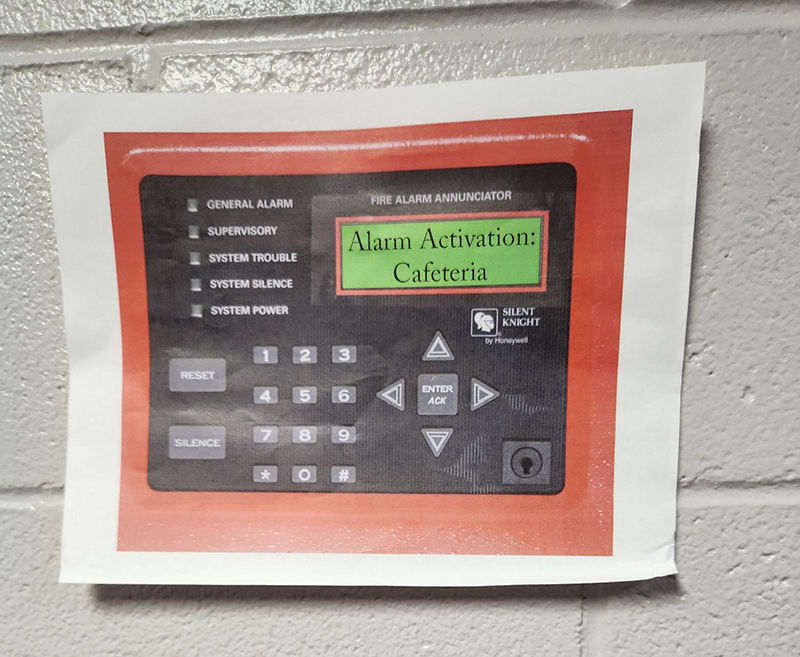
(1) Photos courtesy of Suffolk (VA) Fire & Rescue.
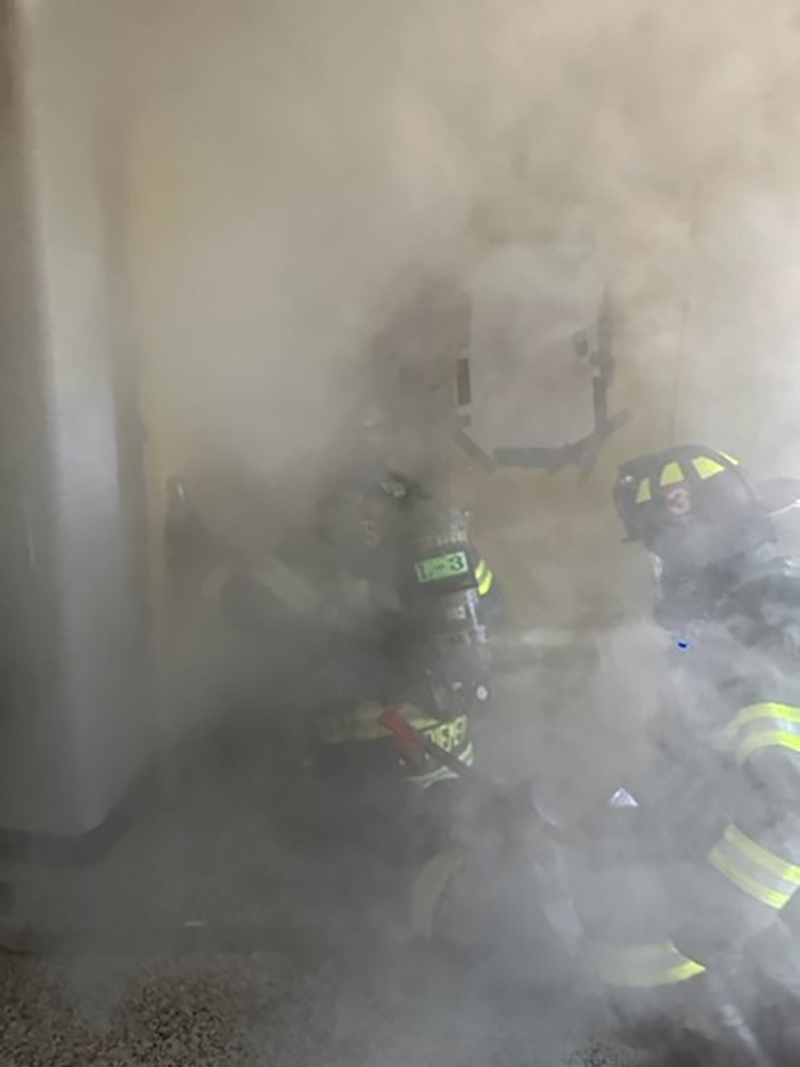
(2)
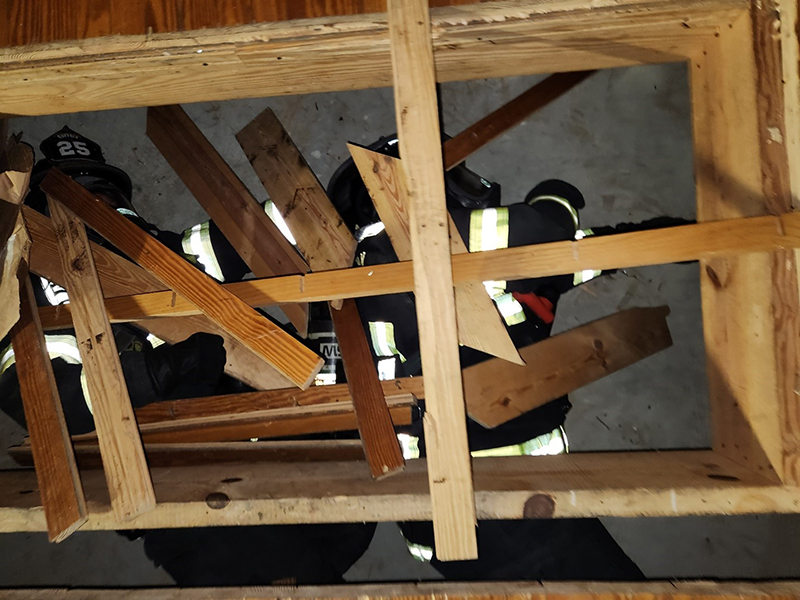
(3)
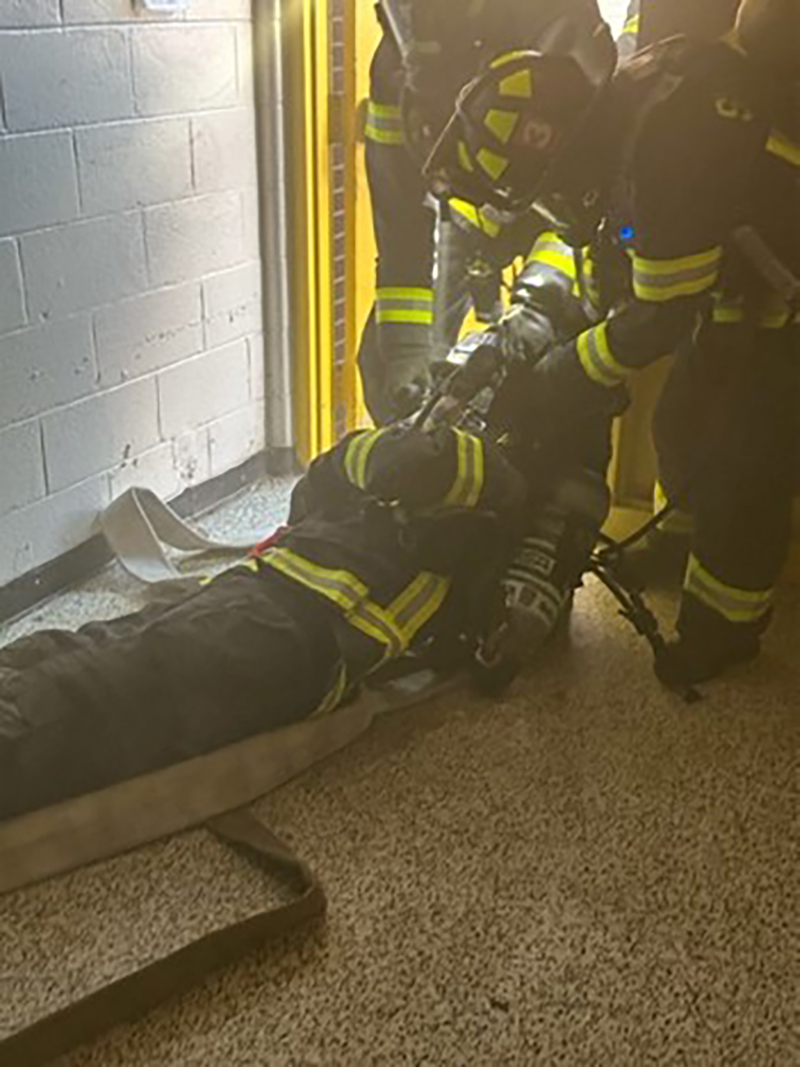
(4)
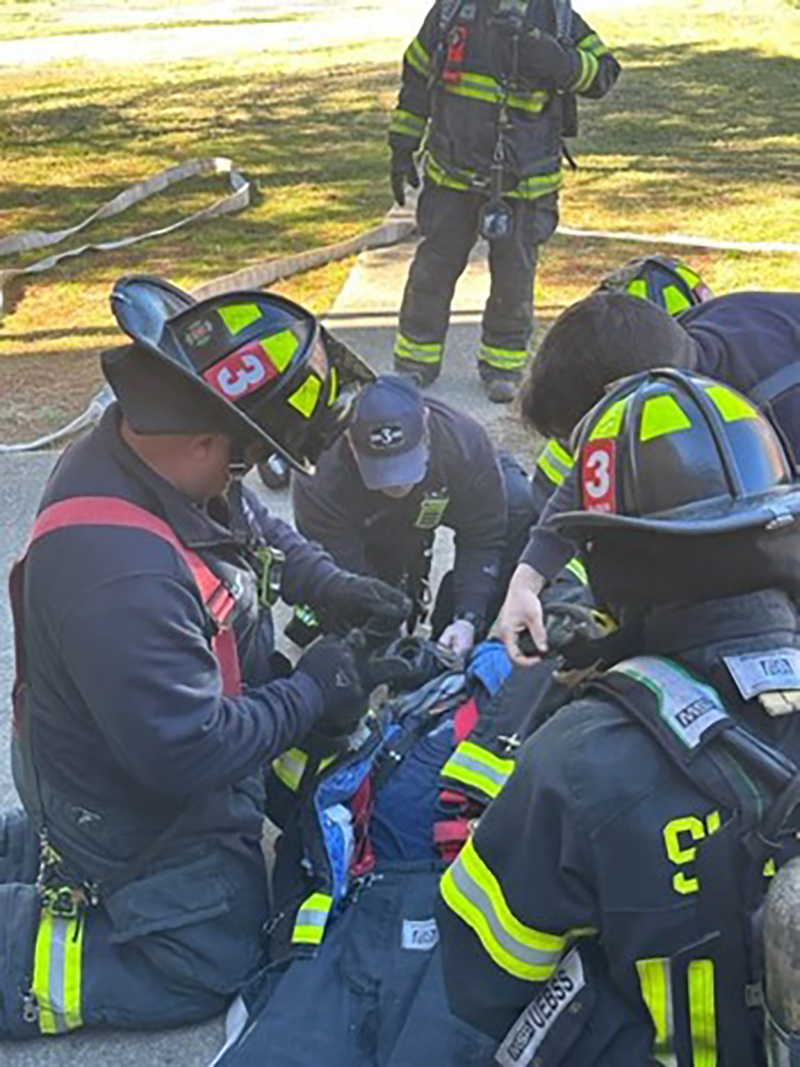
(5)
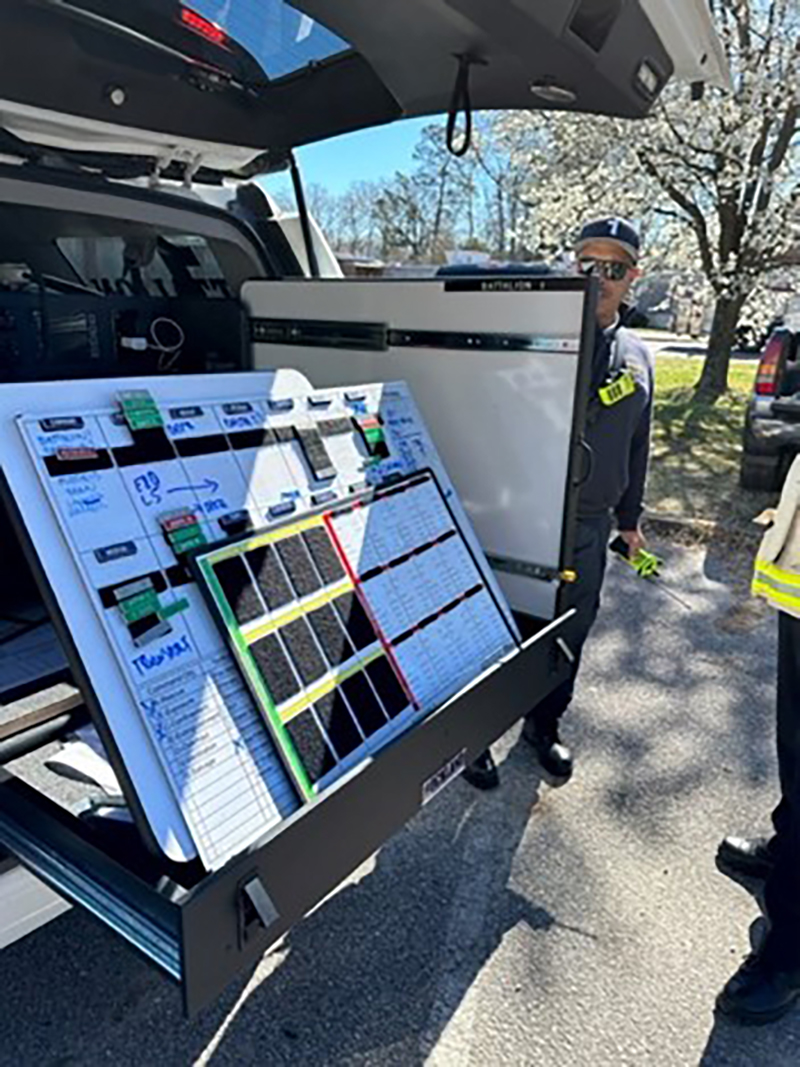
(6)
Keeping It Fresh
As with all exercises, the scenario was built on and developed differently over the 12 deliveries. To ensure the exercise remained fresh and not just duplicated over the two months, the facilitators mixed up the time the Mayday would be declared. The sequence of events or the timing of injects would also be varied.
For example, in the scenario, the attack crew members would be separated and placed into the stage’s hole earlier or the crews would be informed earlier about the missing civilian cafeteria workers. This allowed search crews to know about the missing occupants prior to firefighters activating the audible personal alert safety system device, indicating down firefighters. By varying the timing of the injects, the exercise was kept fresh for all participants, and the IC had to be prepared as the incident escalated during the exercise.
After the Exercise
After each evolution concluded, the participants went through rehab, gear was collected, and trucks were packed and readied for service. The facilitators and evaluators then led a “hot wash” that reviewed the strategy, the tactics, and the tasks that each company and the IC had executed in the evolution. Lessons learned for each evolution were captured and that information will be used to build future exercises and solidify or modify existing policies and procedures for Mayday, large-area searches, and RIT.
Common themes that were identified in all the evolutions included radio communications, the importance of prefire planning, firefighter removal techniques, rescue equipment, RIT packs, SCBA knowledge, tactical/Mayday worksheets, calling for the second alarm early, using ICS terminology (photo 6), using multiple tactical channels, and the dispatcher’s role in fireground communications.
Lessons Learned and Action Items
A formal post-incident analysis (PIA) of all the evolutions occurred with the IC evaluators, the facilitators, the training chief, and the safety officers. The goal of the PIA was to answer the pre-evolution questions: Where are we? Where do we want to be? and What do we need to accomplish to get there? SFR has accomplished the desired outcome with the two full-scale exercises completed and the in-station drills that occurred between the exercises. The execution of a Mayday event has improved. The department is better prepared and ready to execute the rescues of down firefighters, successfully activate and use the RIT, and have the command and control necessary to manage and lead rescue operations of down firefighters.
SFR did expand on the lessons learned from the first full-scale exercise, and the items were identified during this year’s full-scale exercise or carried forward from the first as lessons learned and as action items for future exercises. These lessons follow:
- Communications. During the 2022 full-scale exercise, SFR encountered numerous problems with in-mask communications as communications were challenging with the department’s new in-mask Bluetooth technology. Issues included pairing the firefighter’s portable radio with the assigned SCBA and switching tactical channels while engaged in fire operations. SFR successfully overcame the issues identified with communications during the first full-scale and second full-scale exercises.
- Prefire planning. Before a fire or an incident, it is essential to have detailed prefire plans of target hazards. The IC must have an accurate and detailed depiction of the areas inside commercial and educational buildings for which “landmarks” are often used to describe the areas in the interior—e.g., the cafeteria, the science lab, the atrium, the math hallway, and so forth. In addition, identifying alternate exit/entry points, hazardous areas, roof access points, and utilities is essential for the IC. SFR identified this as an action item in the first full-scale exercise and successfully used the prefire plan to mitigate the searches and firefighter and civilian rescues during the second full-scale exercise.
- RIT packs. The use of RIT packs was highlighted as “in need of improvement” in the first 2022 exercise. The second full-scale exercise demonstrated that the use was exceptional. SFR successfully improved RIT pack use through in-house training and the lessons learned from the first full-scale exercise.
- Firefighter removal. Based on the information and techniques learned after the first full-scale exercise, crews did an excellent job on rescue techniques and air supply when faced with multiple down firefighters in the 2023 exercise.
- Rescue equipment. For the second full-scale exercise, practice and training paid off. Crews were more proficient in and established multiple RIT staging areas, ensured the proper equipment necessary for disentanglement, and established breaching early in the incident. Outside crews had saws running and the proper equipment ready to enter the building once requested.
- Tactical/Mayday worksheets. ICs used many different worksheets that were established and refined after the first full-scale exercise.
- Additional alarms. Following the first full-scale exercise was a complete review of what apparatus and personnel would be necessary once a second alarm was requested with a Mayday event. Was the normal complement received during a second alarm enough to deal with a Mayday operation? Based on the first full-scale exercise, the question was established, “Should more than a second, third, or fourth alarm be requested once a Mayday occurs?” Based on the second full-scale exercise, it is recommended that each department review the effective response for their individual departments by training on Mayday events. It is important to remember that active fire suppression operations must continue while the down firefighter’s rescue occurs simultaneously. A four-firefighter RIT may not be able to execute a successful rescue operation. Through repeated training, determine the number of additional alarms and the effective response necessary to complete firefighter rescues.
- ICS terminology. Many departments depend on resources and apparatus from neighboring departments when faced with a Mayday. Since completing the first full-scale exercise, SFR has established standard operating procedures that clarify “often-used terms” specifically for Maydays that both SFR and responding automatic and mutual-aid departments understand.
- Requesting a separate channel. In the first full-scale exercise, the IC became aware of the need to move incident and Mayday radio traffic to separate tactical channels. As a result of in-station training and the second full-scale exercise, this tactic, if requested by the crew’s operations, will have a smooth transition.
- Dispatch. Integrating dispatchers into Mayday training is necessary, especially if tactical dispatchers monitor tactical channels. Tactical dispatchers must be trained and prepared to assign and monitor multiple tactical channels, know which benchmarks will require additional alarms, and so on. In addition, integrating tactical dispatchers into the full-scale exercises has led to a great rapport with dispatchers and they are eager to participate in future training.
- Annual training. Mayday and RIT skills should be routinely trained on at the company and battalion levels. RIT and Mayday drills must be held annually with full-scale exercises to bring together the crews who will work together when faced with a down firefighter or Mayday event. Exercising the entire department with large-scale evolutions to help to ensure proficiency will lead to modifying practices and policies based on the lessons learned during annual exercises. In addition, empower rescue and ladder companies to get out to stations to perform half-day training on the following exercises: calling the Mayday, buddy breathing vs. transfill, firefighter and victim removal, and RIT packs.
Through the past two full-scale exercises, SFR answered the questions: Where are we? Where do we want to be? and What do we need to accomplish to get there? This was year two of our Mayday drills, for which the entire department, through two exercises, gathered data and analysis of 24 large-scale exercises. We captured lessons and are better prepared for a successful outcome. Facilitators and evaluators saw a vast improvement from the first full-scale exercise to the second, which included more refined rescue techniques, decision making, equipment knowledge, building familiarization, incident command, searches, and firefighter and civilian rescues. SFR focused on the mantra: “We perform as we practice.” Poor training leads to poor performance. SFR is committed to building on these exercises to better prepare our firefighters, officers, and ICs for a Mayday.
OWEN C. THOMASSON III is a 34-year fire service veteran and captain with the Suffolk (VA) Department of Fire & Rescue, assigned to an engine company. He is an officer II, instructor II, advanced emergency medical technician, and NFA incident safety officer. Thomasson has an associate degree in fire science and has developed numerous training programs for his department’s RIT and Mayday operations.
MICHAEL J. BARAKEY, CFO, is a 31-year fire service veteran and the chief of Suffolk (VA) Department of Fire & Rescue. He is a hazmat specialist; an instructor III; a nationally registered paramedic; and a neonatal/pediatric critical care paramedic for the Children’s Hospital of the King’s Daughters in Norfolk, Virginia. Barakey is the participating agency representative and former task force leader for VA-TF2 US&R team and an exercise design/controller for Spec Rescue International. He has a master’s degree in public administration from Old Dominion University and graduated from the National Fire Academy’s Executive Fire Officer Program in 2009. Barakey authored Critical Decision Making: Point-to-Point Leadership in Fire and Emergency Services (Fire Engineering Books), regularly contributes to Fire Engineering, and is an FDIC International preconference and classroom instructor.

